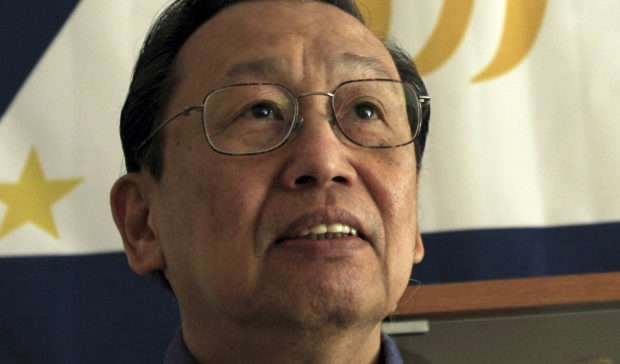
Jose Maria Sison
MANILA, Philippines — The death of Jose Maria “Joma” Sison is not the end of the revolutionary movement, the Communist Party of the Philippines (CPP) said on Saturday in response to the military’s claim that the vacuum left by its late founder would deplete the half-century-old Maoist insurgency.
“Of course, the passing of Ka Joma is a great loss for the Party and revolutionary movement,” Marco Valbuena, the CPP chief information officer, said in a statement.“But like the children taught, guided and trained by their Great Father, the Philippine revolutionaries can stand on their own feet,” he said.
Valbuena was reacting to a post on Facebook by the Civil Relations Service of the Armed Forces of the Philippines stating that the CPP, its armed wing, the New People’s Army (NPA), and political arm, National Democratic Front of the Philippines (NDFP), would be “greatly weakened resulting from the death of their founder.”
“Due to their leadership vacuum, a leadership crisis within the underground organization of the CPP will significantly affect the whole communist movement,” according to the post.
But Valbuena said the courageous stand of CPP members “is a testament to [Sison’s] legacy that the Party and revolutionary movement remain strong, vibrant and determined to carry the struggle forward.”
Sison, 83, in self-exile in Europe since peace talks with the government collapsed in 1987, died in a hospital in Utrecht, the Netherlands, at 8:40 p.m. (Philippine time) on Friday.
The NPA has been waging a Maoist-inspired revolution for more than 50 years, making it the longest communist rebellion in the world.
‘Shared archenemy’s fate’
But the AFP claims that the NPA has only 2,112 combatants left, with their so-called guerrilla fronts reduced to 24 from 89.At its peak, it had 25,200 members in 1987, based on military estimates.
Former Akbayan Rep. Walden Bello, a noted academic and veteran activist, remembered Sison as a “giant of the Philippine Left.”
“We had our differences with Joma … but these do not detract from the fact that he was a giant of the Philippine Left, who, more than anyone else, contributed to its rebirth in the mid-1960s,” Bello said in a statement.
But Rodolfo Salas, who chaired the CPP and headed the NPA starting in 1977 following Sison’s arrest, said the CPP founder “shared the fate of his archenemy,” referring to the ousted dictator Ferdinand Marcos Sr., father of President Marcos.
“Both claimed to be nationalists. In the end, they both died overseas,” Salas, 74, also known as “Kumander Bilog,” said in a phone interview from Angeles City.
In the Cordilleras, activists said Sison’s demise should not stop the revival of peace negotiations between the government and the communist rebels.
“Peace talks should move forward because unless the government—that treated Joma Sison as its nemesis—recognizes its systemic weaknesses, the revolutionary movement will just persist,” said Baguio-based cultural activist and poet Luchie Maranan.
She described Sison’s death as “the passing of an era” in the long history of activism, adding that he inspired “a bold new generation of activists and revolutionaries.”Over the past 36 years, the government and the communist rebels have held intermittent peace talks, often marred by sporadic fighting between state forces and insurgents.
The first peace negotiation between the new government of then President Corazon Aquino and the NDFP took place in November 1986.Mendiola Massacre
The two sides agreed to a 60-day ceasefire from December 1986 to February 1987. The NDFP honored the agreement but withdrew on the day of the Mendiola Massacre on Jan. 22 when riot police opened fire on a farmers’ march near Malacañang, killing 13 and injuring dozens of others.
Negotiations reopened during the administration of President Fidel Ramos, resulting in the signing of various pacts, including the 1992 Joint Hague Declaration urging both parties to resolve the armed conflict through political negotiations, the 1994 Breukelen Joint Statement, the 1995 Joint Agreement on Safety and Immunity Guarantees, and the 1995 Joint Agreement on the Formation, Sequence and Operationalization of the Reciprocal Working Committees.
In 1999, the talks were scuttled after senators allied with then President Joseph Estrada voted to ratify the Visiting Forces Agreement between the Philippines and the United States, allowing American soldiers to hold exercises and train with Filipino troops.
Talks resumed under the presidencies of Gloria Macapagal-Arroyo and Aquino’s son, the late Benigno Aquino III, interrupted from time to time by skirmishes between the NPA and state forces.
Rodrigo Duterte also continued peace talks when he became president in 2016. But he suspended negotiations in November 2017, blaming the rebels for breaking a ceasefire.
Two weeks later, he issued Proclamation No. 374 declaring the CPP and NPA terrorists. (In September, a Manila court rejected the government’s petition to have the two groups proscribed as terrorist organizations).
Later Duterte pursued regional talks through the National Task Force to End Local Communist Armed Conflict, a body that became controversial for Red-tagging, or linking government critics and activists to the communist movement.

